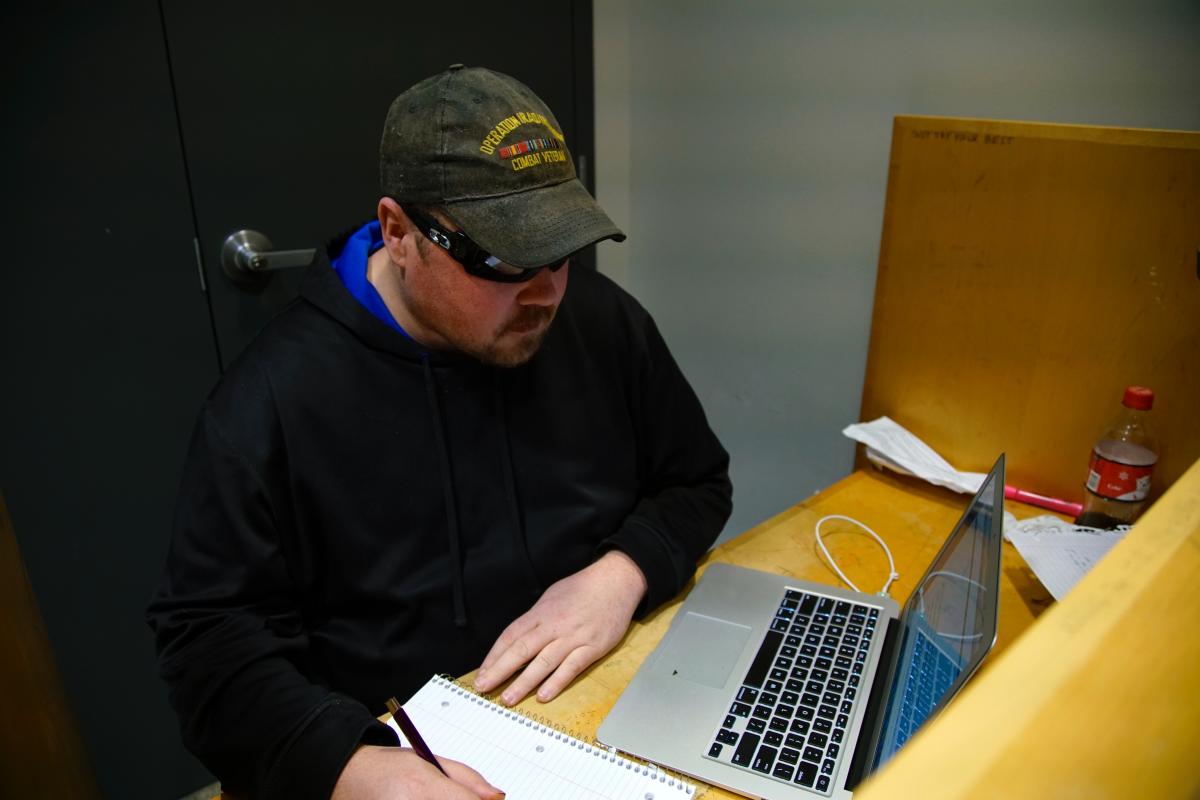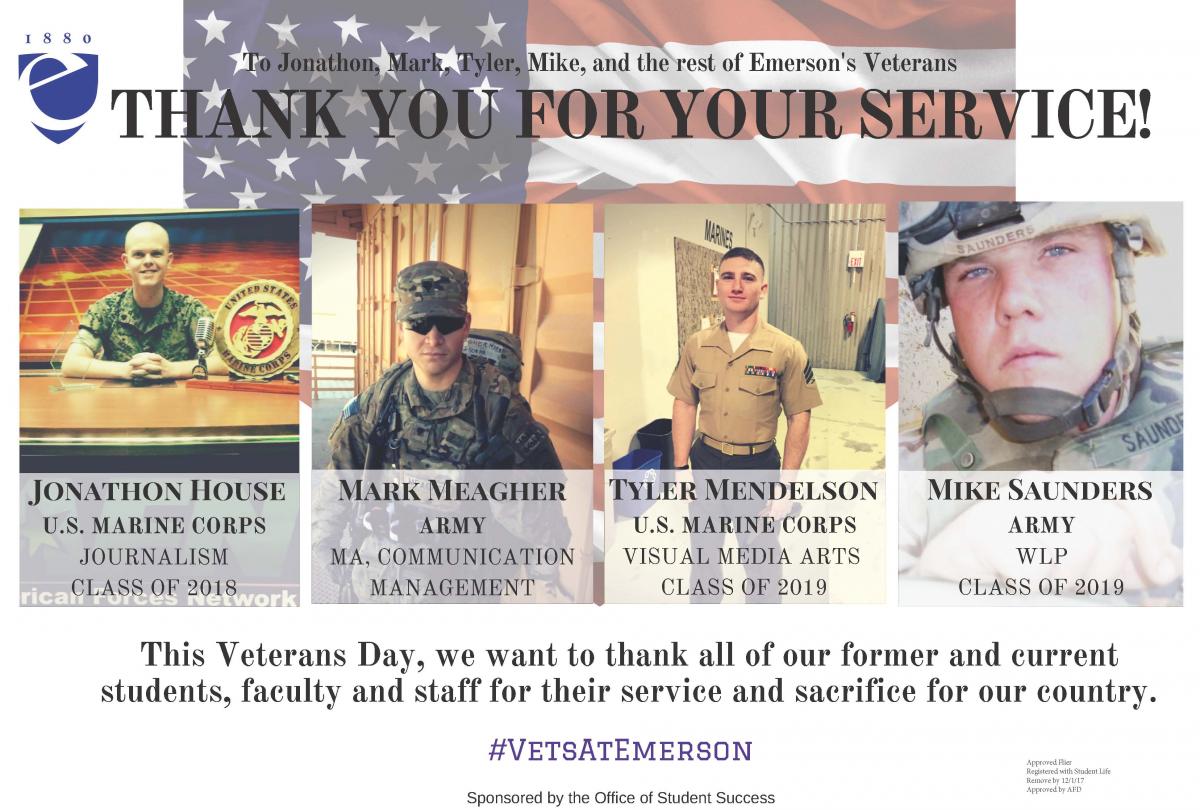Emerson Offers New Start to Military Veterans
Michael Saunders’ path to Emerson College has been long, unconventional, and at certain points, perilous.
The Writing, Literature and Publishing major enrolled this fall after doing a couple of years at a community college. Before that, he said, he held a series of jobs at supermarkets, a lumber yard, an auto parts store, because the economy wasn’t terrific.
Before that, he did two tours in Iraq with the U.S. Army.
Saunders ’19 is one of 13 veterans currently enrolled at Emerson through the GI Bill or Vocational Rehabilitation & Employment funding. (There may be additional veterans studying at the College who are not using any available government benefit.)
“This is basically us starting over,” Saunders, 34, said of himself and his fellow veterans. “We kind of left our late-teen years, and we went off to different things and had huge responsibilities, and successfully [carried them out], and now we’re here and we’re trying to find our way.”
The 13 veterans at Emerson today defy categorization. They vary in age (21–55), politics (conservative to liberal), and major (every department except Communication Sciences and Disorders). They include two women, according to Nate Magnuski, assistant director of retention and student success at Emerson, and the person assigned to be the “point person” for the College’s veterans.
Making College Affordable
“Combat veteran” might not be the first thing that springs to mind when thinking about Emerson, and in truth, they make up just a tiny percentage of the overall student body. But the College has gone out of its way to welcome servicemen and women, and was rewarded for its efforts this fall, when U.S. News & World Report ranked Emerson the #4 Best College for Veterans in the Regional University (North) category.
That ranking is, to a large extent, due to Emerson’s all-in participation in the Yellow Ribbon Program. Tuition at a private four-year institution often exceeds what a veteran’s Chapter 33 (post-9/11 GI Bill) benefit will cover. Schools that participate in the Yellow Ribbon Program agree to contribute some portion of the remaining costs, with funds matched by the Veterans’ Administration.
Some colleges and universities cap the amount they will contribute to a veteran’s tuition bill, but Emerson will make sure that he or she is covered in full, according to Magnuski.
“They still have to be the type of student who wants an Emerson education,” said Vice President for Enrollment Management Ruthanne Madsen. “But if Emerson’s the right place for them, we’re going to get them because they have their GI Bill and they also have the Yellow Ribbon Program.”
Madsen said Emerson used to cap its Yellow Ribbon participants at one or two per year, but when she began investigating what it would cost to commit to all interested veterans, she realized it was both affordable and desirable.
“It definitely helps with diversity, because they’re going to be in the classroom bringing a totally different perspective, just changing the shape and the thought of some of the conversations in the classrooms,” Madsen said. “It’s trying to be as inclusive as possible.”
Different Experiences, Different Needs
As important as financial help is to attracting and retaining veterans, it’s not the whole picture.
Magnuski said veterans may come to Emerson with a whole host of challenges that the typical college freshman doesn’t face: physical disabilities, post-traumatic stress disorder, traumatic brain injuries. His job is to sit down with them and find out who they are, what their goals are, and what the College can do to make sure they’re successful. That often involves communicating with faculty and staff.
“They might need to get up [in the middle of class]; they might need to sit with their back against the wall,” Magnuski said. “It’s really about educating the staff about the reality that the classroom isn’t just 18-year-old students fresh out of high school.”
Emerson is following recommendations in the American Council on Education (ACE) Toolkit for Veteran Friendly Institutions, an online resource for colleges and universities that want to open their arms to veterans. Some of the steps the College has already taken include making an effort to identify veterans on campus and creating a point of contact for veterans to coordinate services.
Bill DeWolf, Emerson’s registrar and himself a 35-year Army veteran, was instrumental in creating formal Call to Active Duty and Military Withdrawal and Reinstatement after Serving on Active Duty policies for students who are in the Reserves and are called up, or who choose to take time out of school to serve in the military.
He also, along with a former veteran student, created an informal student veterans group and a closed Student Veterans Facebook page, though he acknowledges that veterans tend to be very busy and it can be difficult to get veterans in the same room together.
“The thing that people need to understand or think about is the fact that these student veterans are very committed in terms of what they want to do,” DeWolf said.

A Second Chapter
Saunders, who had seen combat while serving in Baghdad and Taji, Iraq, was having nightmares when he got home to Everett, Massachusetts. He went to the Veterans’ Administration for help, and through counseling, decided he wanted to try college.
He enrolled in Middlesex Community College, where he discovered a passion and talent for writing. It was there that he wrote a children’s book about dealing with separation anxiety when a parent is serving overseas; the book, which he’s currently revising, tells the story from both the child’s and the soldier’s perspectives.
When it came time to apply to four-year schools, Saunders said he knew he wanted to continue writing—and he wanted to do it at Emerson. He applied to one other “safety” school, but he was regularly emailing Lisa Yaeger, transfer coordinator in Emerson’s admission office, to check on his application process. (“She probably got sick of me,” he said.)
Until one day, he logged on to the application site and saw his acceptance letter.
“I learned so much about myself in community college that it’s kind of weird being 34 and jumping around like an 18-year-old, but in hindsight, that’s exactly what I did,” Saunders said. “What are the odds of me applying to two schools and getting into the one I had my heart set on?”
Back to His Alma Mater
Marine Corps veteran Jamil Brown also got accepted to Emerson—twice.
Brown went directly to Emerson after graduating from high school in 1992, and four years later, he left with a BS in Filmmaking.
After college, he got a job with US Airways, but felt called to join the Marine Corps. He served as a radioman for 10 years, including a couple of tours in Iraq, one of which cost him his foot. He was discharged in 2008, and in 2011, he decided he wanted to return to his alma mater and pick up his study of film.
Brown, 43, said he has different challenges and post-graduate needs than his 20-something classmates. Having been out of the classroom for so long, he’s been finding school work an adjustment, but, “as they say in the Marine Corps, ‘Adapt and Overcome.’”
Once he gets his MFA, he won’t be able to jet off to California to pursue his career because he has ties to the area. He can’t take an unpaid internship just to get professional experience, because he has a mortgage to pay.
Even his fellow veterans who are closer in age to traditional students are coming from a totally different place, he said.
“Those kids just coming out of high school, they might not know that much,” Brown said. “But [a veteran’s] going to be more experienced; he grew up more quickly. I know guys who are 21 years old who act 45.”
Still, Brown said he’s found his non-veteran classmates to be respectful and curious.
“They ask me questions. They don’t ask me stupid questions; they ask, ‘What was your experience?’” he said. “And they wait for me to answer because they want to know.”

“They’ve Earned It”
Saunders, the WLP major, said the support system he’s encountered at Emerson has been “phenomenal.” He pointed to time-management counseling and Magnuski, in the Office of Student Success, as being helpful, as well as the Lacerte Family Writing and Academic Resource Center, where he has frequent appointments.
But in addition to the numerous supports already in place, Magnuski said he’d like to see the College make even more of a coordinated effort to help veterans. For instance, one of the veteran-friendly recommendations made to institutions is to have a dedicated office for veterans’ affairs, he said. Another is to create a gathering space for veterans to study, socialize, or relax, he said, particularly since veterans tend to be commuter students.
Of course, carving out any extra physical space is a challenge for an urban campus like Emerson’s. And while Emerson’s veteran population is steadily growing—from 7 or 8 in recent years to 13 this year—it’s still very small relative to the general population, making funding for a veterans’ office a tough sell.
But national trends show more and more men and women who have come out of the fighting in Iraq and Afghanistan still relatively young, and are looking for a next step in life, Magnuski said. And with the U.S. News ranking, many of them should be looking to Emerson as a good place to land.
The College is heading in the right direction, but “we’ve got to keep pushing” forward, Magnuski said.
“We need to put the cart before the horse, in this case,” he said. “They’ve earned it. We owe it to them.”
Categories